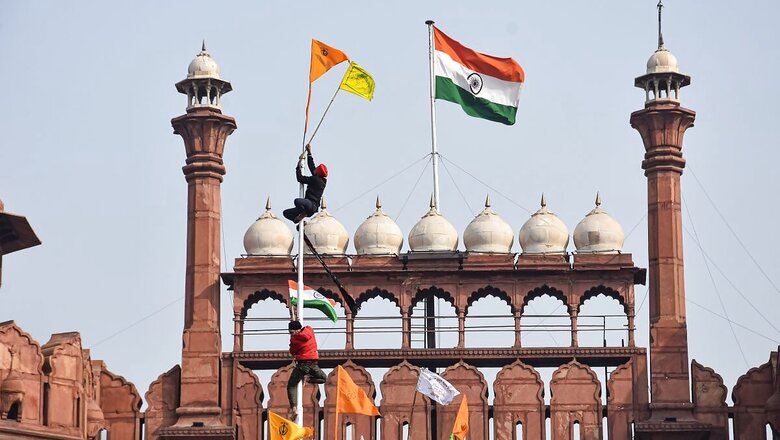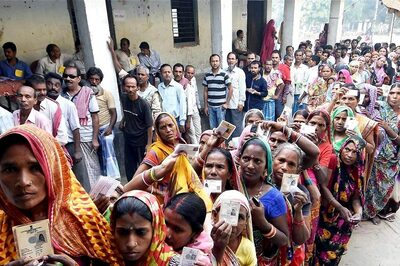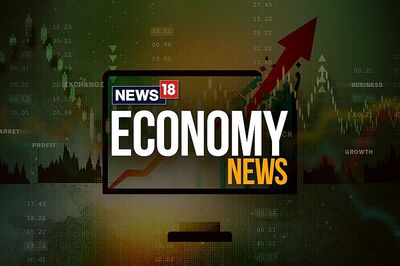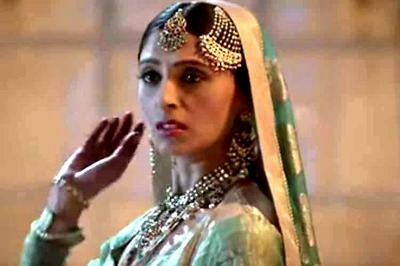
views
The 72nd Republic Day celebrations on Tuesday were unparalleled. Despite the disruptions by the Covid-19 pandemic that demanded a strict social distancing protocol and the last-minute cancellation by the chief guest, the celebrations went exceedingly well.
The symbolic display of valour by the three armed forces, including the debut of the much-awaited Rafale fighter aircraft, was a visual treat for citizens across the country. The portrayal of multiple colours representing art and culture from across states, including one from Bangladesh, looked splendid. While the tableau from Bangladesh underlined the historic and growing friendship between the two neighbours, India put a show that perfectly underscored the national slogan of ‘unity in diversity’.
As the parade passed off with its usual pomp and show at Rajpath, the visuals playing at Red Fort were too bitter to stomach. Anarchy and arson were let loose around the historic monument from where the national flag is hoisted on Independence Day. To the horror of countrymen and women watching TV, a flag representing a particular community was unfurled from the same point. It became a dark day of national shame.
The immediate reaction from various quarters was that this was not expected from farmers. They were given permission by the Delhi Police with certain routes and preconditions to conduct their tractor parade. By violating the agreement, the demonstrators indulged in reckless and ruthless violence targeting mainly the policemen. It was a betrayal. Motives were attributed as farmers’ leaders like Rakesh Tikait had made combative statements. On the surface, it seemed to be so. The farmers lost sympathy and moral support of people.
The other viewpoint was that it was a failure of the administration. The heart-wrenching sights of policemen covered in blood and begging for mercy from the violent agitators were unnerving. It looked like a complete breakdown of law and order and a slap on the government. To be sure, the violence could have been easily anticipated by the police and their intelligence wings. The farmers sitting on dharna for over two months could have run out of patience and let themselves loose. Also, in such highly-hyped demonstrations, there could always be agent provocateurs igniting trouble.
On closer scrutiny of events that unfolded yesterday, there could be at least three perspectives. One, the Union government gave the farmers a long rope, which is normal in democratic politics. While the government negotiated patiently with the farmers, they allowed the dissent to be expressed. It is the farmers who shamed themselves by resorting to violence and dishonouring national symbols like the tricolour.
Secondly, the farmers feel that the violence was orchestrated by the government to discredit their movement against the unjust laws. They contend that the Union government has been trying to divide, defame and distract their movement from day one. They say it’s only the farmers of Punjab, Haryana and Western Uttar Pradesh who are protesting, whereas elsewhere in the country the farmers have accepted the new laws. The government’s spokespersons pointed proximity of the ultra-left and even pro-Khalistani elements with the farmers. The opposition parties having failed in previous attempts to needle the ruling party were latching on to the farmers to further their political cause. Thirdly, as conspiracy theories go, there are invisible hands wanting to weaken our country.
Admittedly, in an adversarial democracy, unity is an unrealistic expectation. One should celebrate the diversity of opinions and respect differences arising out of it. But they must be expressed in a non-violent way. And what happened yesterday was pure violence, not dissent. On a solemn occasion like the Republic Day, such mayhem in the name of protesting cannot be condoned. Whoever let that happen must be brought to book so that such egregious events are not repeated. How do we fix accountability?
As a matter of putting the pieces together to complete the puzzle, let us look at the preparation by the Delhi Police to meet such an eventuality. The police were heavily outnumbered and were without the usual riot gears. They were provided with a lone lathi to stop the angry and agitated young men who were carrying swords and iron rods. It is also now known that farmers from Singhu Border did not indulge in the violence but those coming from Ghazipur and the eastern corridor did. This contingent of farmers led by controversial Deep Sidhu, who was the election agent of Sunny Deol, a BJP MP, managed to find its way to the Red Fort. Sidhu is said to be the one who hoisted the religious flag from the ramparts of the Red Fort. Sidhu’s group was not a part of the Samyukta Kisan Morcha comprising 40 farmers unions. He had made a provocative speech just before the march and announced that he will not follow the route agreed by the farmers and the police.
Whatever happened yesterday could be a lapse, a deviation or distortion of democracy. But the moot point is the farmers’ demonstration has been going on for over two months. How and when does one end it? Contradictions in society can crop up, but they have to be resolved. Dialogue, debates and effective communication are essential mechanisms in a democracy: they help in reconciling differences, easing tensions and exposing the vested interests. Are we not faltering in using such mechanisms?
Read all the Latest News, Breaking News and Coronavirus News here



















Comments
0 comment